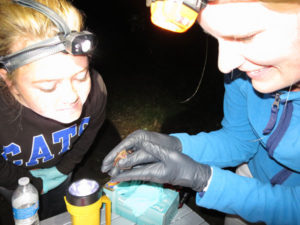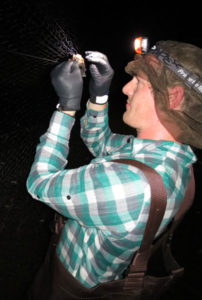We have recently completed netting at our second site, in the Embarras River Bottoms State Habitat Area near Lawrenceville, Illinois. After two nights of mist netting, we captured five bats of three different species – the big brown bat (Eptesicus fuscus), red bat (Lasiurus borealis), and tri-colored bat (Perimyotis subflavus).

Ash and Tara examin a tri-colored bat captured at Embarras River Bottoms State Habitat Area. After collecting data on the animal for a few minutes, it will be released.
The Embarras River site was a location of interest for this project because it is currently in the beginning stages of restoration from a designated Superfund site. Contamination of the site occurred due to a refinery that operated from the early 1900s to 1995. The Illinois Department of Natural Resources is currently working to restore the site so baseline information on wildlife populations is of critical importance.
The capture of a tri-colored bat at this site was especially exciting for our team since this species is becoming rare within its range of the eastern United States. The tri-colored bat population has most likely been declining due to white-nose syndrome, however it is difficult to know due to the limited information available for this species.

Matt S carefully removing a bat from the mist net in Lawrence County, Illinois, so that we can weigh, measure, identify, and determine sex and age class of the bat.
The big brown bat and red bat were also important captures because it is important to keep track of species while they are common so that population changes are more likely to be recognized. The red bat may not be seriously impacted by white nose syndrome, but recent winter counts of the big brown bat in Illinois are suggestive of population declines, even though this species does not commonly show obvious signs of the disease during winter surveys.
We are looking forward to many more nights of mist netting ahead of us but for now, we need more coffee!

